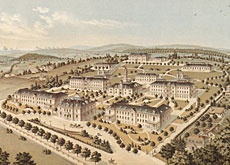Bern hospital has long history

One of the oldest infirmaries in Switzerland, the University Hospital or Inselspital in the capital Bern, is celebrating its 650th anniversary this year.
Founded in 1354 by a rich widow, the internationally renowned institution has come a long way from its humble beginnings.
What began as a foundation caring for 13 people with three staff is now Bern’s main hospital, with 600 workers looking after 40,000 patients and 200,000 outpatients every year.
Not much is known about the founder, Anna Seiler, who specified in her will in November 1354 that a hospital should be set up after her death and funded by her estate.
“In the knowledge that nothing is more certain than death and that nothing is more uncertain than the hour of death… I wish to establish a hospital, in which 13 bedridden and needy persons should be accepted, as well as three honest people to look after them,” she wrote.
Plague
A few years earlier, in 1348, Bern had been ravaged by the plague, and the population’s suffering must have been uppermost in Seiler’s mind.
Her husband, Heinrich, was governor of a Bernese hospital, and she had worked alongside him in the administration and as a carer.
On his death, she became the wealthiest woman in Bern, owner of numerous properties, as well as land and other riches.
Seiler’s decision to bequeath her wealth for the care of the infirm was not unusual for the time – many a wealthy widow expressed the same wish. And stipulating the number 13 was common, in homage to Jesus and the 12 disciples.
But whereas many widows left their money to the Church, Seiler left hers to the public authorities, said Nicolas Barras, an archivist at the Swiss Federal Archives.
“At that time, there were many rich widows making donations to set up foundations… but what Seiler did was innovative… because her legacy created a strong link between her establishment and the ruling powers in Bern,” Barras told swissinfo.
Establishment
When Seiler died in 1360, the first hospital bearing her name was established in the town’s Zeughausgasse but 100 years later, her wishes that the poor should benefit from her legacy were forgotten and the institution became an old people’s home for the wealthy.
With the advent of the Reformation in the 16th century, the public authorities were reminded to respect Seiler’s original wishes and the hospital’s doors were open once more to the poor.
Around the same time, the foundation moved to an empty convent on St Michael’s Insel or island, situated where the Swiss houses of parliament stand today. It also became known as the Inselspital.
The renamed hospital took off as an institution in the 18th century, ironically after its buildings burnt down in 1713. The new establishment was compared to a royal palace and had room for 70 adults and 12 children.
By 1884, the Inselspital was bursting at the seams and moved to its present location on the Kreuzmattareal. A year later the new 340-bed hospital opened.
It became a centre for training doctors and gained an excellent international reputation.
From 1958, the present-day hospital finally took shape – over the next two decades, the multi-storey main building, operating theatres, laboratories and other clinics were built.
Anniversary
As part of the anniversary celebrations, the Inselspital is staging a series of events with the main goal of bringing health issues to public attention.
These events include a special exhibition, a gala event and information days on health issues.
Hospital spokesman Charly Einstein told swissinfo that the anniversary would focus on the hospital’s role at the heart of the Bernese health system.
“Our goal is to show what we are able to do for the Bernese people, to demonstrate they can rely on us 24 hours a day, 365 days a year,” Einstein said.
“It is quite something that we can celebrate 650 years. There are not many institutions that have that age and tradition.”
swissinfo, Faryal Mirza
The Inselspital is celebrating its 650th anniversary in 2004.
It was set up in 1354 by a rich widow, Anna Seiler, to look after 13 sick people.
It now cares for more than 200,000 patients annually.

In compliance with the JTI standards
More: SWI swissinfo.ch certified by the Journalism Trust Initiative









You can find an overview of ongoing debates with our journalists here . Please join us!
If you want to start a conversation about a topic raised in this article or want to report factual errors, email us at english@swissinfo.ch.